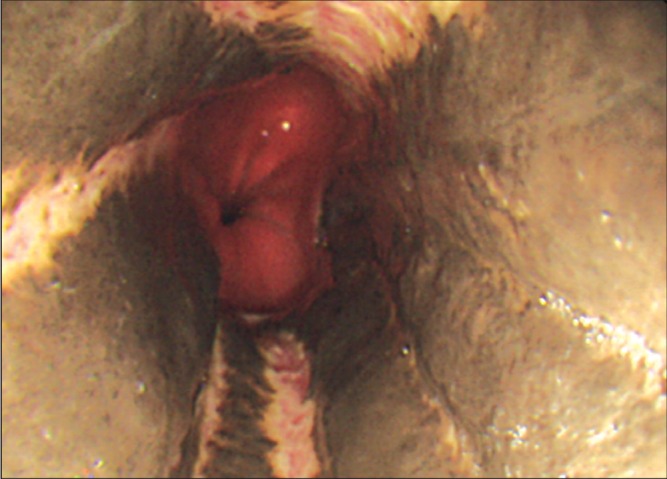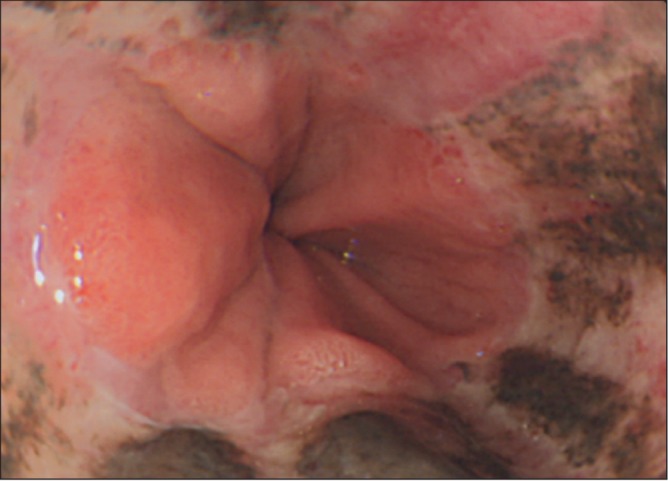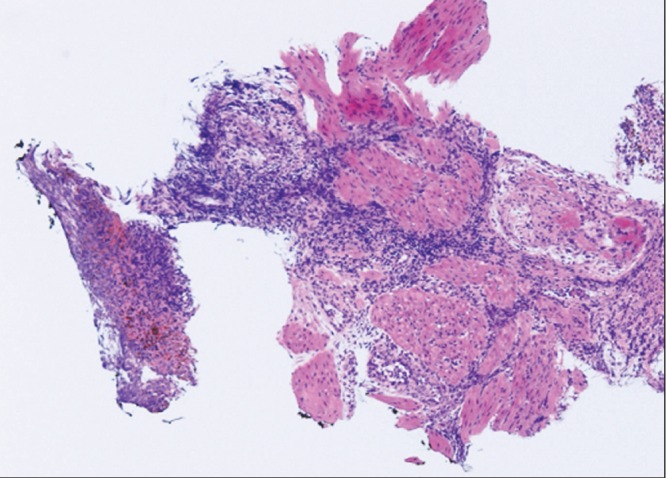CASE PRESENTATION
A 38-year-old man undergoing insulin therapy for type 1 diabetes mellitus was brought to the emergency room with a consciousness disturbance that was subsequently diagnosed as diabetic ketoacidosis. The patient developed several episodes of hematemesis shortly after hospitalization. Esophagogastroduodenoscopy (EGD) revealed typical findings of acute esophageal necrosis (AEN) with thick black stripes involving the distal esophagus, with a sharp demarcation at the squamocolumnar border (Figure 1). Treatment with intravenous fluids, insulin therapy and a proton pump inhibitor was initiated, and the patient was kept nil per oral. His blood glucose level normalized during hospital day 1, and his gastrointestinal symptoms and hematemesis also resolved. On day 4 of hospitalization, black stripes were less prominent on follow-up EGD (Figure 2). Endoscopic ultrasound (EUS) using a 20 MHz probe was also performed. EUS revealed thickening of the submucosal layer at the black stripes with an intact muscularis layer (Figure 3), suggesting the submucosa as the principle site of the lesion in the recovery phase. Narrow-band imaging (NBI) without magnification showed diffuse dark brown areas and disappearance of the superficial vascular network at the black stripes. NBI magnification between the black stripes revealed dilation and tortuosity of intrapapillary capillary loops without calibre change, consistent with inflammatory mucosa of superficial membranes (Figure 4). Histological analysis of the black stripes showed leukocyte infiltration with hemosiderosis. In addition, there were no definite findings of bacterial, fungal or virus infection such as cytomegalovirus and herpes simplex virus (Figure 5). He was discharged on hospital day 7 without complications such as esophageal perforation and stricture.
Figure 1).

Typical findings of black esophagus with thick black stripes involving the distal esophagus with sharp demarcation at the squamocolumnar border
Figure 2).

Necrotic stripes were less prominent on follow-up esophagogastroduodenoscopy
Figure 3).

Endoscopic ultrasound revealing thickening of the submucosal layer on black stripes with intact muscularis layer
Figure 4).

Narrow-band imaging magnification suggesting disappearance of the superficial vascular network at black stripes. Narrow-band imaging magnification between the black stripes revealed dilation and tortuosity of intrapapillary capillary loops without calibre change
Figure 5).

Biopsy of black stripes revealed leukocytic infiltration with hemosiderosis. Neither multinucleated giant cells, viral inclusion bodies nor fungus were observed. Hematoxylin eosin stain, original magnification ×4
DISCUSSION
AEN, also known as ‘black esophagus’, is a rare clinical disease characterized by black pigmentation of the distal esophageal mucosa (1,2). Gastrointestinal bleeding is the most frequent clinical manifestation. Although the etiology of AEN is unclear, it is likely multifactorial, arising from an ischemic insult, impaired local defense mucosal barrier systems and backflow injury from gastric contents (3). AEN has been reported in association with diabetic ketoacidosis (4). Gurvits et al (5) proposed a longitudinal staging system (stage 0 to 3) based on endoscopic and histological findings. According to this staging system, initial EGD and follow-up examinations, including EUS and NBI, are performed in stage 1 and 2, respectively. The present report is the first to describe advanced endoscopic imaging of black esophagus, suggesting that the submucosa was mainly involved in the recovery phase. These findings may contribute to further understanding of the pathophysiology of this rare disease.
The Canadian Journal of Gastroenterology & Hepatology is considering a limited number of submissions for IMAGE OF THE MONTH. These are based on endoscopic, histological, radiological and/or patient images, which must be anonymous with no identifying features visible. The patient must consent to publication and the consent must be submitted with the manuscript. All manuscripts should be practical and relevant to clinical practice, and not simply a case report of an esoteric condition. The text should be brief, structured as CASE PRESENTATION and DISCUSSION, and not more than 700 words in length. A maximum of three images can be submitted and the number of references should not exceed five. The submission may be edited by our editorial team.
REFERENCES
- 1.Goldenberg SP, Wain SL, Marignani P. Acute necrotizing esophagitis. Gastroenterology. 1990;98:493–6. doi: 10.1016/0016-5085(90)90844-q. [DOI] [PubMed] [Google Scholar]
- 2.Augusto F, Fernandes V, Cremers MI, et al. Acute necrotizing esophagitis: A large retrospective case series. Endoscopy. 2004;36:411–5. doi: 10.1055/s-2004-814318. [DOI] [PubMed] [Google Scholar]
- 3.Gurvits GE. Black esophagus: Acute esophageal necrosis syndrome. World J Gastroenterol. 2010;26:3219–25. doi: 10.3748/wjg.v16.i26.3219. [DOI] [PMC free article] [PubMed] [Google Scholar]
- 4.Yasuda H, Yamada M, Endo Y, Inoue K, Yoshiba M. Acute necrotizing esophagitis: Role of nonsteroidal anti-inflammatory drugs. J Gastroenterol. 2006;41:193–7. doi: 10.1007/s00535-005-1741-6. [DOI] [PubMed] [Google Scholar]
- 5.Gurvits GE, Shapsis A, Lau N, Gualtieri N, Robilotti JG. Acute esophageal necrosis: A rare syndrome. J Gastroenterol. 2007;42:29–38. doi: 10.1007/s00535-006-1974-z. [DOI] [PubMed] [Google Scholar]


